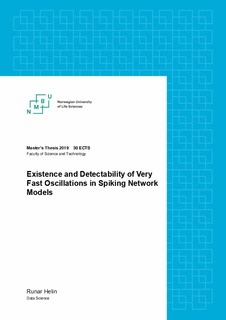| dc.contributor.advisor | Plesser, Hans Ekkehard | |
| dc.contributor.author | Helin, Runar | |
| dc.date.accessioned | 2019-09-06T10:45:38Z | |
| dc.date.available | 2019-09-06T10:45:38Z | |
| dc.date.issued | 2019 | |
| dc.identifier.uri | http://hdl.handle.net/11250/2612925 | |
| dc.description.abstract | Extremely high frequency oscillations are present in dynamics of different simulated neuronal networks, but are not yet observed in experimental recordings. This raises the question about the origin of these high frequency oscillations. Focusing on the microcircuit model of an area in the visual cortex, it is shown that the oscillations, visible as vertical stripes in raster plots from population activities, are related to peaks in the power spectra of the population-averaged firing activities. It is shown that the oscillations are not caused by the time discretization of the spike detection in the simulation of the network or the use of discretized delay values.
Given the difference in the number of neurons between experimental recordings and the populations in the network model, a subsampling of neurons from the network model with different sample sizes was performed to analyse the oscillations for subsamples of neurons with similar sizes as the experimental recordings. The results show that peaks in the power spectra can be observed for subsamples of few hundred neurons from a population, given that the whole population shows sufficient oscillatory activity.
Analytical results for the power spectra of the microcircuit model described by Bos et al. [2016] show that the choice of delay distribution for the inhibitory connections in the model has a large effect on the peaks. This network model originally uses a truncated Gaussian distribution for the synaptic delays. The use of an exponential delay distribution shows a spectrum with no peaks for frequencies above 100 Hz for any of the populations. Analytical power spectra from models using uniform and lognormal distribution for the delays have peaks in the power spectra around 80 Hz and 300 Hz, similar to the spectra from the model using a truncated Gaussian distribution. The amplitudes of the peaks are not the same for the models with different delay distributions. This is explained by the different contributions of each eigenmode obtained from the connectivity matrix of the network. It is also shown that varying the parameters of the delay distribution greatly shifts or scales both the low and high frequency peaks, making it possible to tune the parameters to manipulate the oscillations of the network dynamics.
The dynamics of area V1 from the multi-area model are analyzed for oscillations. The results show that the oscillatory dynamics are almost completely gone. | nb_NO |
| dc.description.abstract | Ekstremt høyfrekvente oscilleringer er tilstedeværende i dynamikken til ulike simulerte nevronale nettverk, men har enda ikke blitt observert i eksperimentelle målinger. Dette fører til spørsmålet om opphavet til disse høyfrekvente oscilleringene. Ved å fokusere på ”microcircuit”-modellen for et område i synssenteret i hjernen vises det at oscilleringene, synlig som vertikale striper i raster plott fra populasjonsaktiviteten, kan kobles til topper i ”power”-spekteret til den populasjons-gjennomsnittlige fyringsaktiviteten. Det vises at oscilleringene ikke oppstår på grunn av diskrete tidssteg i simuleringen av nettverket eller å bruke diskrete ”delay”-verdier.
På grunn av forskjellen mellom antall nevroner i eksperimentelle målinger og størrelsen på populasjonene i nettverksmodellen, en ”subsampling” av nevroner med ulike utvalgsstørrelser ble gjennomført for å analysere oscilleringene for utvalg med et antall nevroner i samme størrelsesorden som i de eksperimentelle målingene. Resultatene viser at toppene i ”power”-spekteret kan bli observert for så lite som noen få hundre nevroner, gitt at populasjonen viser tilstrekkelig oscillatorisk aktivitet.
Analytiske resultater av ”power”-spektrene til ”microcircuit”-modellen, som forklart av Bos et al. [2016], viser at valget av ”delay”-fordelingen til de inhibitoriske koblingene i modellen har en stor effekt på toppene. Denne nettverksmodellen bruker opprinnelig en trunkert Gaussfordeling for de synaptiske ”delayene”. Ved å bruke en eksponentiell fordeling til ”delayene” observeres det ingen topp i de analytiske ”power”-spektrene for frekvenser over 100 Hz. De analytiske ”power”-spektrene for modeller med uniform- og lognormalfordelinger til ”delayene” viser topper både for rundt 80 Hz og 300 Hz, tilsvarende resultatene fra å bruke modellen med den originale trunkerte Gaussfordelingen. Amplituden til på toppene i spektrene er forskjellig for modellene med de ulike ”delay”-fordelingene som kan forklares ved de ulike bidragene til spektrene fra de ulike eigenmodene tilhørende koblingsmatrisen til nettverket. Det er også vist at variasjon i parametrene til delayfordelingene har en stor påvirkning på både posisjonen og amplituden til toppene i ”power”-spektrene. Dette gjør det mulig å tune parameterne for å manipulere den oscillatoriske dynamikken i nettverket.
Dynamikken til området V1 av synssenteret i hjernen fra ”multi-area”-modellen er analysert for oscilleringer. | nb_NO |
| dc.language.iso | eng | nb_NO |
| dc.publisher | Norwegian University of Life Sciences, Ås | nb_NO |
| dc.rights | Attribution-NonCommercial-NoDerivatives 4.0 Internasjonal | * |
| dc.rights.uri | http://creativecommons.org/licenses/by-nc-nd/4.0/deed.no | * |
| dc.subject | Spectral analysis | nb_NO |
| dc.subject | Oscillatory dynamics | nb_NO |
| dc.title | Existence and detectability of very fast oscillations in spiking network models | nb_NO |
| dc.type | Master thesis | nb_NO |
| dc.subject.nsi | VDP::Matematikk og Naturvitenskap: 400::Informasjons- og kommunikasjonsvitenskap: 420::Simulering, visualisering, signalbehandling, bildeanalyse: 429 | nb_NO |
| dc.source.pagenumber | 78 | nb_NO |
| dc.description.localcode | M-DV | nb_NO |

